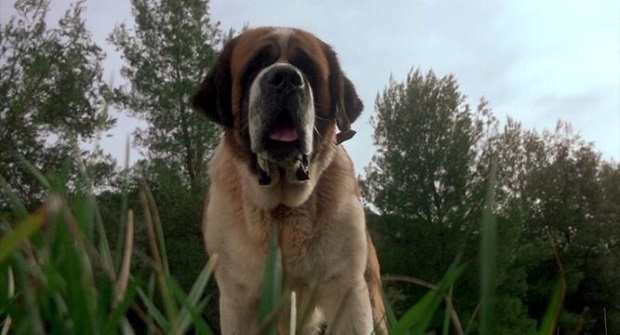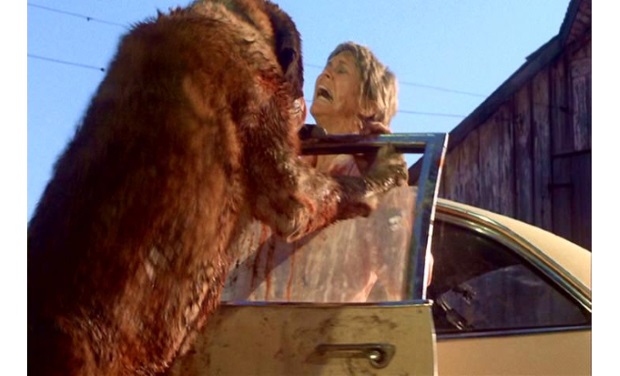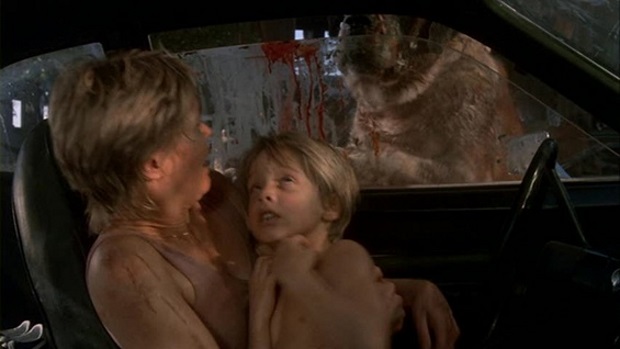Revisiting the film of Stephen King’s Cujo
It's a book that Stephen King doesn't remember much about writing. But how does the film of Cujo fare?
This article comes from Den of Geek UK.
The Film: The Trentons, consisting of Vic, Donna and their son, Tad, have recently moved to Castle Rock, Maine from the big city. He’s an advertising exec with a campaign in crisis, she’s a bored housewife having an affair with local bearded wonder, Steve. Meanwhile, the pet of Joe Camber, a nearby mechanic, is a dog named Cujo, who has unfortunately been bitten by a rabid bat during a rabbit chase. When Donna journeys up to the Cambers to get their car fixed with Tad in tow, they have no idea that the now rabid Cujo lies in wait for them.
Stephen King openly admits he has little memory of writing Cujo, as he put the book together during the height of his alcohol addiction. It carries a few of the regular hallmarks: smalltown Americana ravaged by a menace, a family unit at the heart of it all attempting to keep it together, and a fevered writing style with no chapters, just breaks in the text as King switches between scenes. There are some fantastic moments of tragedy peppered through it, particularly the ending and when it comes to Cujo himself. King allows the dog its own perspective running through the book, his limited mind unable to cope with or fight his changing mental state.
In the hands of a lesser writer, the moments of Cujo’s interiority where he questions his sudden mania could be corny, but King manages to make it a heart-wrenching insight into the decline of an otherwise good-natured dog. The film attempts to replicate this on occasion, focusing on Cujo’s droopy expression during the middle of the narrative, particularly in the encounter with Joe’s son, Brett. The dog chooses to walk away instead of attacking. Director Lewis Teague also adopts Cujo’s point-of-view in some of the attacks, giving those moments a real sense of feral brutality. It might not work on the same tragic level as the Cujo scenes in the novel, but it does further that idea of Cujo succumbing to the infection.

The opening credits follow Cujo’s fateful rabbit chase, presenting nature as something idyllic and playful at first. A goofy Cujo bounds about, chasing the rabbit as it hops across luscious greenery in the summer sunshine. Everything about the scene has an amiable ‘aw, shucks’ kind of feel. When Cujo gets his head stuck in the bat cavern, that mood changes fast. The bats are screeching, Cujo is barking, the score mounts until a bat bites down hard on Cujo. That switch is a microcosm of the film to come; the friendly side of the natural world in all its cuddliness suddenly transforming into something violent and terrifying.
When we get to the human characters shortly afterwards, Teague delights in playing with some childhood horror conventions as Tad faces down the imaginary monster in his closet with looming shadows slinking across his bedroom walls. It’s a fun little sequence that plays with audience expectations; it’s a Stephen King movie. Surely there’s something in the closet? But no, as Tad’s father patiently explains, monsters aren’t real. And thus, we get to the real tragedy of Cujo. There is nothing supernatural going on here. It is just a series of unfortunate events that have violent, terrifying consequences.
In this sense, the film departs somewhat from the book and in doing so, carves its own identity within the story. In the novel, there are hints that Cujo has not just been infected with rabies, but also possessed by the spirit of a local serial killer, Frank Dodd (who featured prominently in King’s previous novel, The Dead Zone). They may only be brief, but it is enough to get those supernatural cogs whirring. Teague worked with Don Carlos Dunaway and Lauren Currier on the adaptation and they offer no such comfort in knowing things don’t really go bump in the night because a rabid dog is a situation that could be all too real.

The special effects work for Cujo is one of those well-known behind the scenes stories; dogs licking the foamy egg white and sugar mix off their faces, wagging tails having to be strapped down and, on occasion, the dogs playing Cujo have a tendency to look a bit too jolly in a couple of scenes where he is supposed to be menacing. The skill in Teague’s direction is that, in the moment, you don’t remember these things. You just see a huge and ferocious dog attacking a car in a frenzy or waiting for the opportune moment to attack again.
The scenes in the car benefit enormously from the performances of the wonderful Dee Wallace as Donna and Danny Pintauro as Tad. Wallace doesn’t really do so well in the bored housewife scenes leading up to the car-set moments, but once there, she’s fantastic as a mother fighting for the survival of her child, whilst also attempting to remain calm herself. In the same way that the film presents Cujo as an example of ‘nature red in tooth and claw,’ it also offers an example of a mother’s primal instinct, doing whatever she can to protect her child. When it looks like Tad is on the brink of death from dehydration, Donna mounts a last ditch attempt to save him and faces down the rabid dog in an amazing moment of maternal heroism.

The ending is also a more hopeful than the novel’s (a change King acknowledged was necessary for the film version) by giving Donna that moment of triumph and uniting the family after the fight with Cujo. Teague chooses to end the movie on a nice and cheesy freeze frame of Vic clutching Donna and Tad to him having found them just after Donna rescues herself. Given the film’s message that sometimes monsters are real and nature is out to get you in a horrible fashion, it’s a good note to end on, emphasising that there are times when we also get to triumph over the things that would hurt us.
Cujo is one of those films that seems to have grown in audience appreciation over the years and it’s easy to understand why. It’s a real primal kind of horror, one that relies on chance and random acts of nature to provide the scares. As Teague states, “the theme of Cujo is that people should only be afraid of real fear” and though we like to get thrills from seeing humans battle supernatural forces, there’s something truly unsettling in the thought that the family pet could suddenly turn so nasty.
Scariest Moment: When Cujo leaps at the car for the first time and starts scrabbling to get through the window. Yeesh.
Musicality: Composer Charles Bernstein was drafted in to score Cujo and plays about with convention during the film. Rather than the traditionally oppressive mood music you would expect to accompany a horror film, Bernstein weaves a sense of romanticism and drama into his score, particularly in the film’s main title. When the percussive accompaniment to Cujo’s demise gets gradually more fierce, it has the desired effect, contrasting sharply to the more elegant music heard earlier in the film.
A King Thing: Stephen King’s Maine. Cujo is our first story set in that staple of the King landscape, Castle Rock, Maine, a fictional setting for many of his tales. Terrible things happen in Castle Rock; I’m not sure why anyone would want to move there. I mean, there’s always Derry.
Join me next time, Constant Reader, as we head into The Dead Zone…
Follow our Twitter feed for faster news and bad jokes right here. And be our Facebook chum here.
